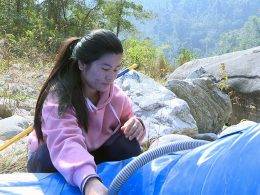Nestled within the verdant forests of Buli village in Zhemgang District, Buli Tsho (Lake) is more than just a serene body of water. At an elevation of 1,372 meters and spanning approximately two hectares, this sacred lake is revered as the abode of Tshomen Kuntu Zangmo, also known as Buli Moenmo—a guardian deity depicted as half-woman, half-snake. For the local Khengpa community, Buli Tsho embodies a rich tapestry of mythology, spiritual significance, and ecological importance.
The Divine Origins of Buli Tsho
The lore surrounding Buli Tsho is deeply woven into the cultural fabric of the region. One prominent legend narrates that Tshomen Kuntu Zangmo journeyed from Tibet to Bhutan in the 17th century, following her brother who later became the Buli Ponpo, or local chieftain. Upon arriving in Buli, she sought shelter in an old woman’s home. That night, the woman glimpsed a large snake in place of the young woman. By morning, the guest had vanished, leaving behind a butter churner. Subsequently, the old woman became prosperous, attributing her fortune to the mermaid’s blessing.
Another tale speaks of the lake’s formation at the spot where a stranger had rested overnight. The next day, a lake appeared, and a farmer’s daughter began exhibiting unusual behavior. She disappeared, and her father found several perfectly made pots at the lake, except for one defective pot, which he kept. This pot brought him wealth, and his descendants assumed the Buli Ponpo-ship thereafter.
These narratives underscore the lake’s sanctity and its integral role in the community’s spiritual life. Residents perform rituals at Buli Tsho, offering prayers, milk, and khadhar (ceremonial scarves) to the deity, seeking blessings for health, prosperity, and protection from misfortune.
Harmonizing Tradition and Ecology
Recognizing the ecological and cultural significance of Buli Tsho, concerted conservation efforts have been initiated. The Royal Society for Protection of Nature (RSPN), in collaboration with the Watershed Management Division (WMD), developed the Buli Watershed Management Plan, active from July 2018 to June 2023. This plan aims to protect the watershed’s rich biodiversity, which includes broad-leaved forests, wetlands, and endemic species like the Royal Bengal tiger and Golden Langur.

Local beliefs have inadvertently contributed to conservation. The community’s reverence for Buli Tsho has led to the preservation of its pristine condition. For instance, the belief that certain individuals—such as those who have handled a dead body, recently lost a spouse, or women during menstruation—should not visit the lake has minimized human interference during sensitive periods.
Furthermore, the lake’s surroundings have been designated a heritage forest by the Department of Forest and Park Services (DoFPS), reinforcing its protected status.
Ridam: The Practice of Sacred Closure
Integral to the community’s conservation ethos is the practice of Ridam (also known as Ladam), which involves the temporary closure of sacred natural sites to human activity. In Buli, this practice is observed during the harvest season, coinciding with the 8th Bhutanese month. During this period, access to Buli Tsho is restricted, based on the belief that disturbances can lead to natural calamities or illness.
Ridam serves both spiritual and ecological purposes. By limiting human activity, it allows the environment to regenerate, ensuring the sustainability of natural resources. This traditional practice exemplifies how indigenous knowledge systems can contribute to modern conservation strategies.
Buli Tsho stands as a testament to the harmonious coexistence of cultural heritage and environmental stewardship. Its legends continue to inspire reverence, while community-led conservation efforts ensure its preservation for future generations.








